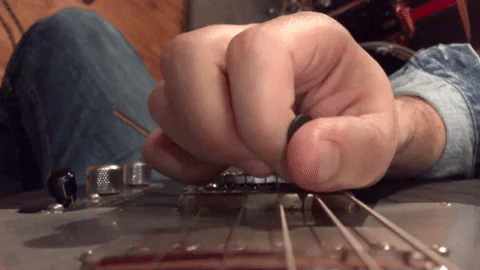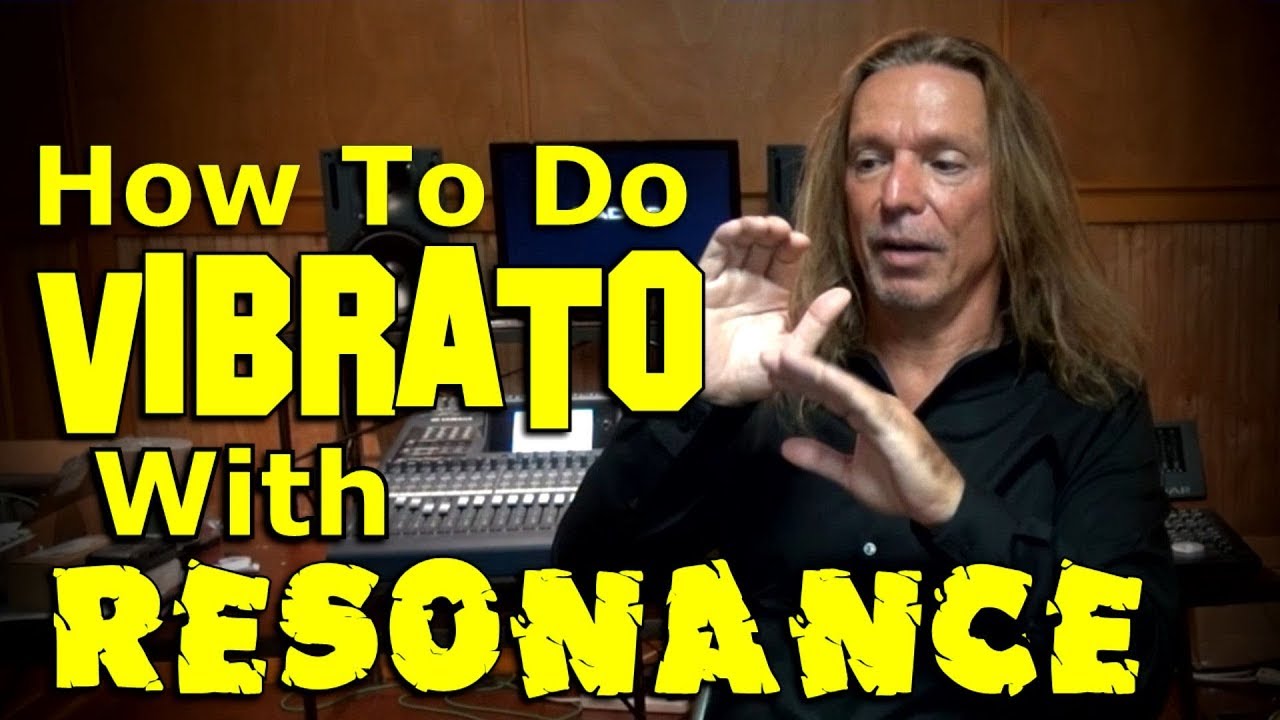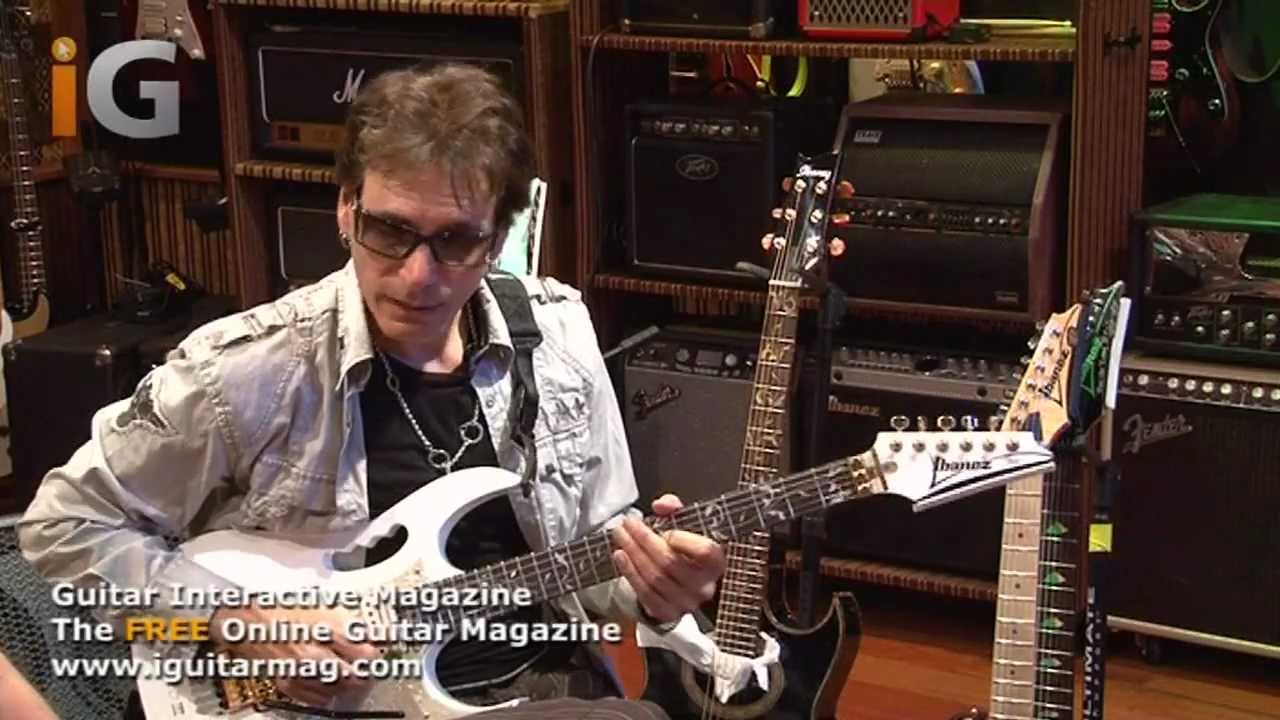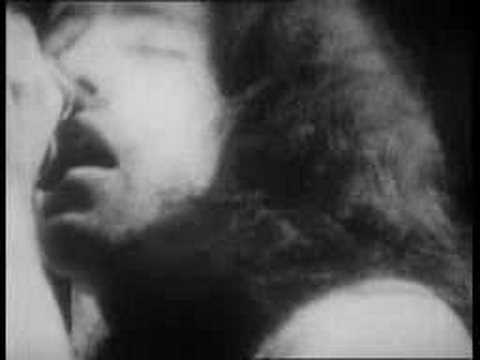If you’ve got a decent pivot vibrato (by which I mean the ‘standard’ guitar vibrato: rotating the forearm and pulling strings downward, as opposed to the whole-arm-shake or violin vibrato), did you learn it first slow and then speed it up? Or, like pickslanting, is it a technique you can only really do fast?
Well I found in my journeys I actually vibrato at tempo. So I can “practice” it slow or fast. I found I “learnt” vibrato by listening to great players and then trying to find ways to emulate that. Eventually I found my own voice.
I used to do specific vibrato practice and it was most often slow, I never tried to practice fast vibrato. I also prefer a slower quarter note or max eight note vibrato.
I’ve heard people say they hate that style (MAB) but I don’t agree and find really fast vibrato played out over time sounds better tremolo picked.
I didn’t find that. I revisited my vibrato recently and practiced to a metronome, doing 8th 16ths, triplet and sixtuplet vibrato to various tempos. I just found that the difficulty is in activating the muscles to get the vibrato accurate in the first place and once that’s accomplished it readily speeds up without having to adjust anything.
I learned it pretty slowly and exaggerated. I even remember it helping to play the vibrato to a metronome, just for control purposes. This all of course went away it became second nature very much a ‘feel’ thing. I’m sure most guys who are just natural badasses at vibrato like SRV didn’t have to do this. I am not a natural though so I had to work for it. My pickslanting and shredding is still a work in progress, but I was always proud of my vibrato back in my ‘band’ days. Here’s one of my better recorded solos where there’s a good bit of vibrato:
I don’t remember, to be honest! But like most oscillating motions, where the oscillation is generated by the momentum of the arm and hand moving at a certain speed, let’s call it the resonant frequency, I find that it’s difficult to find the right motion at a much slower speed (ie frequency). So yes, I think that to a certain extent it has to be practiced at speed!
(As an aside, I don’t think “pickslanting” can only be done fast. Do you mean that finding the right, fast, motion can only be done by playing fast?)
There’s all kinds of considerations. Speed picking can definitely be musical, but it is essentially a mechanical solution to a mechanical problem. Vibrato is at the heart of musicality.
So you have to kind of dig deep and ask the big questions, like “where does music come from?” First of all, I would propose that, at the very least, the appreciation of pitched music (especially non-harmonized, soloistic expression) stems from our inborn psychological response to vocal tones.
So I’d say be very aware of what vocal vibratos sound “natural” vs. “forced.” Sometimes a “forced” vibrato can be cool, but it’s still not a window into answering the “musicality” question as far as what’s inherently “musical” in a tone.
Two things to be aware of: 1) The motions you’re talking about will all tend to push the note sharp – I know, that’s kind of the idea, right? But still, realize that the pitch center ends up being at the bottom of whatever oscillation you’re doing. So you’ve got to be aware of the perceived pitch center vs. your track or what your backing band is doing. Maybe some of the other folks on here can elaborate, because I don’t feel like I’m breaking this down in an easy to understand way, but when every tendency is pushing the note “up” (even fretting a note “a little too hard” will push it sharp), your lead will sound sharp kind of regardless of what you do. If that’s not your intention, it can take away from any kind of “pro” sound. If you practice without any kind of track (or a looper, or something), you might not even be really aware of it.
- The speed of the oscillations isn’t exactly constant – the ACCELERATION up/down is. So the pitch center moves in what looks like a sine wave. Synth programmers will know this from setting their LFO to “sine wave” and not “triangular wave,” but this is a REALLY tough one to explain. Basically, if you’re going after a “natural” vibrato (emphasizing “musicality” and not “effect,”) the actual rate of pitch change will slow down at the top and the bottom. If you see a strings player – violin, etc. – or a fretless bass player’s vibrato, this might make sense. Basically, they spend a little more time at the extreme ends of the oscillation than in the middle. Again, maybe someone can help clear this up. This is key to having it not sound “shaky.” Hey, if you’re making a punk record, maybe “shaky” is what you’re aiming for, but anyway…
So this is a vocal vibrato lesson by Ken Tamplin, who is a really great singer. The F# he hits here is a nice note, with a very musical vibrato in my opinion (he’s demonstrating vibrato and not timbre). Note that the pitch peaks at the F# with the vibrato really happening BELOW the note. This isn’t the only approach, but it is really a cool way to go that’s not immediately apparent on guitar.
My advice is to hit an E or F so you’re actually starting below the note, do a quick bend UP to the target note, and then try to see if you can get this kind of timing and pitch “dip” going. Obviously, this is only one example. But something like this will take your focus off the “guitaristic” and set your focus on what is “musical.” I can all but guarantee that what will happen, over time, is that you’ll fall into your own “rhythm” at some point.
Kind of like this – I don’t think it’s “perfect” or anything, but I’m really trying to match his rate and amount of “dip” below the note.
By the way, I’m bringing this up to point out the idea of “pitch center,” but I should repeat that the pitch center can also be at the bottom with the vibrato occurring only “up” as well – in fact, that’s kind of the typical way on guitar.
“Classical” and circular vibrato can go sharp and flat – here’s Steve Vai talking about it:
I still can’t into good vibrato )
Anyway, I wonder what does Stevie mean by ‘goig flat’? I mean, unless you somehow move your fret back or make string tension less you can’t go lower than default fretted non-vibrato note. Well, unless you press it hard usually and then press it more softly during vibrato.
I’m old school, never used a metronome with vibrato. On a non-bent note I just practiced slowly with a quarter step and maybe a half-step vibrato until I could keep it in tune and get some endurance with it. Eventually I started doing some faster vibratos, but I think its harder when learning to accurately gauge being in tune with fast vibrato. For bending up it was a similar approach, I also started slow and bent up to the note, released and bent back up to it and sped it up later. I listened to guys like Hendrix, Trower, and Schenker to gauge what “right” sounds like.
Sure you can! I’d thought the same thing too – I thought that was “reserved” for fretless instruments. But the classical guitar vibrato (which is pretty much the same as cello/double bass) will drive the note a little flat. The different tension on a nylon string really allows for a lot of expression vibrato-wise. I’m playing a 3/4 steel string practice guitar here, though.
I think what the classical vibrato does is pretty much drive a little string mass toward the bridge, decreasing the tension a little bit. That’s the feeling at the fingertip. I definitely get it below the reference note. I’m playing an A here against the A string, using minimal fingertip pressure to test the fretted note against the open string.
This vibrato works well with chords, and getting a sharp/flat oscillation is doable there, too.
A lot of these tricks are kind of studio necessities, especially with layered tracks. It’s kind of like, the worst thing to be (in the context of a “polished” record) is a little sharp and/or a little ahead of the beat (really, the pitch thing comes into play more with singing). Oh, boy, THAT’s a hard one to explain…
Ah, damn, I forget that pressing a string farther from fret makes it ‘less perfect’. It was so long ago when I played acoustic…
To me, it doesn’t “start out” flat – it’s only going flat as my fingertip pressure pushes forward (towards the bridge). And I’m kind of trying to exaggerate it. But I don’t think I’d get below the reference note just fretting with (light) downward pressure only, regardless of where I pressed down. The tactile feeling for me is something along the lines of the wrist oscillation causing the fingertip to “brake” momentarily against the string windings as I swing toward the fret/bridge. The trick is to push the string towards the bridge while maintaining minimum effort into the fretboard as far as “fretting” pressure. At around 7 or 8 seconds in the video, I hold one for a sec without “vibrato-ing” it.
That’s the funny part of the classical vibrato, the oscillations feel like a release when switching direction, kind of like the wrist/finger tension acts as a “spring” that pushes you toward the mean position. So the feeling isn’t so much that you’re micro-managing the accelerations and decelerations of the movement as that you’re pushing with the same light “effort” in each direction and letting the bounce-back happen, kind of “joining in” with the bounce-back for the direction change, like pushing on a swing at the right time to get that harmonic motion going.
For me, the concept and function of vibrato is based on rhythm. One should be able to play effective vibrato at a snail’s pace as well as hyper drive. Gary Moore had one of the sweetest vibratos ever. Check out his slow blues to feel the rhythm and groove of his technique. Santana also had a great slower vibrato.
What I mean is that the consensus on the forum seems to be that you can’t learn to pickslant at other than uptempo. Maybe you execute it slowly once you’ve ‘got it,’ but the learning has got to be done at a brisk speed. That’s what I’m understanding, anyway.
That’s interesting. I’ll have to experiment with that.
Thanks for those responses. Guess I feel okay now about working it up from slow.
I’ll leave vibrato to the other commenters, but just a reminder on the thread title: pickslanting refers to the orientation of the pick versus the guitar. It’s not a picking motion. There are lots of efficient picking motions, and some don’t use a pickslant. For example:
Even motions that you think of as “pickslanting” really aren’t. You can do John McLaughlin’s picking motion in the air in front of you, and it’s not really slanted in any particular way. It’s just the combination of arm position and joint motion and grip that make it look a certain way when you do it on a guitar.
I know when you say “slanting” you really mean “picking motion”, so not a knock — more of a reminder for others reading who may not.
Thanks for that point. I guess to be more precise I should say single-escape, because that’s a motion. But since you don’t really single-escape without slanting, I just said slant.
At any rate, I think I’ve understood from others here that single-escape learned at slow tempo will develop mechanics that won’t work when single-escaping fast. So that’s what I’m referencing when I ask, and I’ll try to be more precise here, too: can you develop mechanics that yield a vibrato at slow tempo and still apply those same mechanics (i.e. motion) to get a tight, fast vibrato…?
I know that we have come to think of certain motions as always using a pickslanted orientation, but that’s not really true, even for very common motions. Andy Wood’s DSX technique has no slant most of the time, and lots of players use this particular combination of arm position, grip, and wrist motion:

More generally, there is nothing categorically different about single escape motions versus double escape motions when it comes to learning. An unfamiliar motor skill is an unfamiliar motor skill, so when you’re starting out, you want to try and get the general hang of it in whatever speed range where it normally occurs. That’s really the only way to know if it’s kinda sorta correct. To start.
I would imagine that process would be the same no matter what the physical skill, even vibrato. If you don’t at least try it at its “normal” speed, how can you tell if it’s right or not?
I want to add that with enough edgepicking I even can do escaping motion with ‘incorrect’ pickslanting, e.g. USX with UWPS, or DSX with DWPS )
I know, it’s just Paul Kossoff making guitar faces. But if there’s a “rawk” scale from 1 to 10, I give this sound a “12!”
Anyway, here’s an example of a lead break where pretty much every long note is fretted and then vibrato’d going up from the pitch center. First of all, I hear it as maybe “rebellious and energetic” (maybe a little “frenetic” even) as opposed to, like, something smooth or buttery. I think the speed (kind of fast) and the fact that those long notes only go “up” help to create that almost-but-not-quite out of control vibe there.
Kind of switching it up a bit more. Mr. Big the band was named after this song. Nice Marshall Major to his right, although I don’t think it’s turned on. That’s OK – it’s probably waaaaay too loud already where he’s standing, 6 inches in front of that 100 watt Plexi…
–
I think there’s classic, badass music here, IMO. But I would also point out that a saxophone or vocal vibrato would not be the same – some of those spots strike me as REALLY “guitaristic,” if that makes sense. Talking about vibrato gets deep into the “musicality” thing really quickly. But I think once you get a couple of motions down, you’re kind of stuck confronting those kinds of big questions. And there is the question of what is “inherently musical” vs. what is “affected” (maybe musical but dependent on context). Remember, TRUE vibrato in a voice (and, hence, in some wind instruments which function similarly) is something we have a deep seated psychological response to – there is an ACTUAL vibrato that comes from an actual resonant phenomenon in a voice (clarinet players can do it too). Our brains are wired to subconsciously perceive it a certain way, and being able to grab hold of that expression might help in making inroads to making choice notes sound “natural.”
Maybe, if you like the occasional thought experiment, ask yourself why you like music in the first place, or why it does what it does? I know, it kind of sets you up for a zen moment, but I think a lot of folks, maybe most musicians, play and sing what’s cool to them without ever contemplating some kind of fundamental bottom line, like, “WHY do I like this?”





